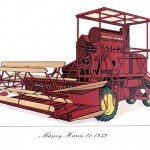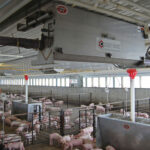Massey Ferguson Celebrates the 75th Anniversary of the MH-20
At the SIMA, Paris Show Massey Ferguson begins its celebrations to honour the 75th anniversary of the introduction of the MH-20 – the world’s first ever self-propelled combine harvester. Introduced in 1938, the MH-20 pioneered a harvesting revolution, for the...
Massey Ferguson Celebrates the 75th Anniversary of the MH-20
At the SIMA, Paris Show Massey Ferguson begins its celebrations to honour the 75th anniversary of the introduction of the MH-20 – the world’s first ever self-propelled combine harvester. Introduced in 1938, the MH-20 pioneered a harvesting revolution, for the...At the SIMA, Paris Show Massey Ferguson begins its celebrations to honour the 75th anniversary of the introduction of the MH-20 – the world’s first ever self-propelled combine harvester.
Introduced in 1938, the MH-20 pioneered a harvesting revolution, for the first time separating the tractor from the trailed reaper machines, providing large area farmers with huge gains in productivity and performance. The machine not only made a massive leap forward in farm mechanisation, but also introduced the term ‘combine harvester’ and laid the foundations for further harvesting innovations.
 And today Massey Ferguson continues to be pioneer new thinking. With many years of experience of working closely with farmers to develop new equipment to meet the challenges of today and tomorrow, the company relishes the opportunity to be the catalyst for new ideas and new techniques, as it has so often in the past.
And today Massey Ferguson continues to be pioneer new thinking. With many years of experience of working closely with farmers to develop new equipment to meet the challenges of today and tomorrow, the company relishes the opportunity to be the catalyst for new ideas and new techniques, as it has so often in the past.
“Massey Ferguson is currently enjoying increased success in its global performance, mainly based on major investments across its product line that are geared to meet the needs of a very diverse range of farmers, who need a complete line up of machinery that they can depend on.
“Against this background Massey Ferguson is very pleased to announce the beginning of a year of celebrations to commemorate 75 years of the self-propelled combine harvester,” comments Campbell Scott, Brand Development Manager.
“Massey Ferguson is hugely proud to have been the innovator of so many designs that are now found as standard on farm machinery, such as three-point linkage, Electronic Linkage Control and SCR engine technology. We are also immensely proud that our forefathers in Massey-Harris were the first to introduce a self-propelled combine harvester.
“As we celebrate this remarkable achievement, and its 75th anniversary, we look forward to reaping the rewards of our major investments in harvesting technology that we have seen over during the past three years, and ensuring continued success for farmers, new and old, who put their faith in our brand,” he adds.
The MH-20 – the world’s first self-propelled combine
The Massey-Harris MH-20 – the world’s first successful self-propelled harvester – was probably the most significant development in harvesting history. Introduced in 1938, the Massey-Harris MH-20 combine harvest not only replaced the name ‘Reaper-Thresher’, but arrived as the first ever serious rival to trailed harvesters, which were already popular in many countries. Although there had been other attempts to develop self-propelled combines, up till then none were successful.
But the new Massey-Harris harvester was an immediate success. It worked well, it was popular with large area cereal growers and it was the first in a new generation of harvesters that would eventually replace trailed models on all but the smallest farms.
One reason for the why the MH-20 succeeded where others failed, was the long established expertise Massey-Harris acquired designing and building grain harvesting machinery. Another crucial factor was the skill of Tom Carroll, leader of the MH-20 design project. Tom was an Australian who moved to Argentina and was then recruited by Massey-Harris for his specialist harvest machinery knowledge.
He was keen that Massey-Harris should develop a self-propelled combine and managed to obtain approval for the ambitious project. He and his team started work on the combine at the company’s engineering centre in Canada in 1936 and within two years eight pre-production prototypes were delivered to farms in Argentina for the field test programme. Feedback on their performance was so positive that production was authorised immediately and the first of the revolutionary new combines were delivered to customers early in 1939.
Tom designed the new harvester as a high output machine for large area growers. It was equipped with a 16ft (4.9m) header which was wide by 1930’s standards. Although the MH-20 was a heavy machine and expensive, it proved to be popular with customers who wanted the benefits of self-propelled harvesting.
The layout of the MH-20 was similar to a modern combine with the header at the front where it could open up a field without the risk of crop damage caused by the wheels of a trailed combine. The driving position was above the centre of the header with an excellent view of the cutting action, and the steering wheels at the rear gave good manoeuvrability compared with a tractor-powered combine.
The MH-20 was built on a steel girder chassis and was powered by a petrol engine which was also used, together with some driveline components, in Massey-Harris tractors. The petrol tank for the engine was under the driver’s seat.
With the new combine performing well with big acreage growers, including export demand from countries such as America and Argentina, Massey-Harris was already working on the next project. The aim was to develop a new smaller, lighter and more affordable self-propelled harvester providing a combine that would sell in large numbers to smaller farms.
Sales of the big MH-20 totalled an impressive 925 machines over two years, but when the new MH-21 combine arrived in 1941 with its 12ft (3.7m) header it created a huge demand with annual production peaking at 10,000 plus in 1949.
During the Second World War Massey-Harris, with the MH-21, pioneered the ‘Harvesting Brigade’. The company gained permission to build a fleet of combines, which worked from the southern states following the ripening harvest north, and in the process harvested more than a million acres in one year.
With the MH-20 and MH-21 combines Massey-Harris achieved an important breakthrough in grain harvesting, which other combine manufacturers were forced to follow. Tom Carroll’s role in the success story was not forgotten and he was awarded a Gold Medal in 1958 by the American Society of Agricultural Engineers to recognise his contribution to combine harvester development.



